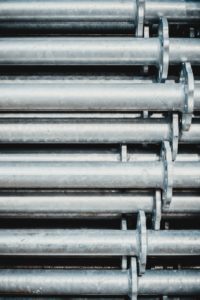Abrasive blasting, sometimes referred to as bead blasting, has been used to clean, strip, shape and restore surfaces for over a century, and for good reason – this process of projecting various media across a surface is a thorough and efficient finishing method for many materials. Abrasive blasting can not only benefit but even improve the function of applications.
Some advantages of abrasive blasting include:
- Cleaning complex part surfaces
- Removing old or thin coatings
- Preparing surfaces to receive fresh coatings
- Achieving the desired surface texture
- Efficiently removing burrs or other imperfections
At RP Abrasives, our blasting capabilities can be applied to virtually all materials, particularly stainless steel, aluminum, titanium, and certain plastics.
To ensure the best outcome, it’s important to understand which media are used for each surface. We’ve covered the basics you need to keep in mind when choosing an abrasive blasting media for your surface treatments.

Consider Surface Characteristics
What material are you working with? This is the first step in deciding which abrasive media you will need to use. The hardness, shape, size and type of material surface all play an integral role in determining the type of blasting media “grit” that is required. Grit sizes can range from super fine to very coarse in order to accommodate these variables, so knowing which media works best for your required surface treatment is crucial to a superior finished product.
Know Your Media Options
Blasting media is used for a variety of surface treatments such as stripping, etching, cleaning, and polishing. Generally, the blaster should use the finest abrasive necessary to attain the desired surface characteristics. This will help prevent any unwanted etching or errors.
RP Abrasives offers a selection of media in different sizes, or “grits,” to allow for texture customization of parts. The media we use include:
- Glass beads
- Aluminum oxide
- Garnet
- Silicone carbide
- Walnut shell
Each media has different qualities, properties and purposes for material surfaces.
Walnut shell – Not only is this media biodegradable and organic, making it the most environmentally-friendly and safe, but it is also gentler than other media options. Walnut shell grit is excellent for use on softer surfaces while still maintaining durability.
Glass beads – This method is ideal if you’re looking for a bright, smooth, shiny finish. These are often made from very fine soda-lime glass and, because the media is so fine, there is minimal stress placed on the material which decreases the chances of etching. This media is cost-effective and recyclable up to 30 times.
Aluminum oxide – Harder and sharper than glass beads, this media is long-lasting with an expansive grit size range of very coarse to extra fine. It’s ideal for using to remove paint, cleaning applications, and for removing burrs. This is the most widely used abrasive for surface finishing.
Silicone carbide – For more aggressive material surface treatments, such as removing paint or rust, silicone carbide is your best choice for etching of hard surfaces like stone and glass. It is the hardest blasting media available and is able to be recycled and reused more often than other media.
Garnet – This media is used for sandblasting due to its superior hardness. It offers ideal coating prep and adhesion properties
RP Abrasives is proud to offer a wide range of abrasive blasting services and have the capability to precision blast parts to ensure we can accommodate your unique application needs. To learn more about our abrasive and bead blasting services, contact us today!
